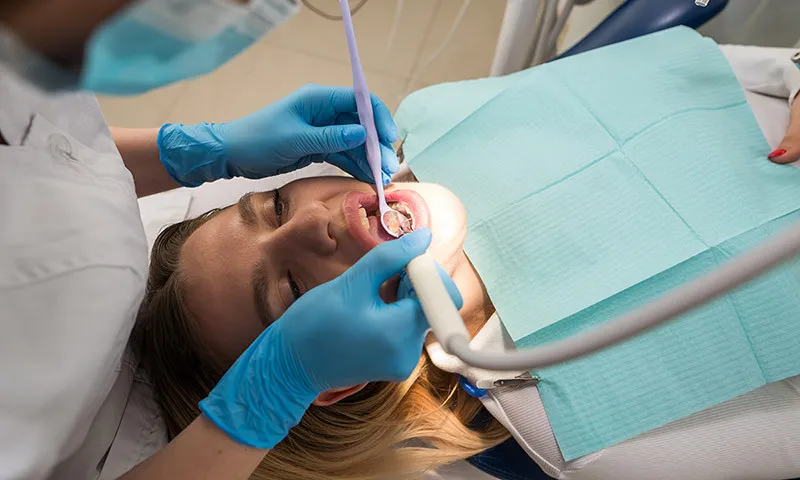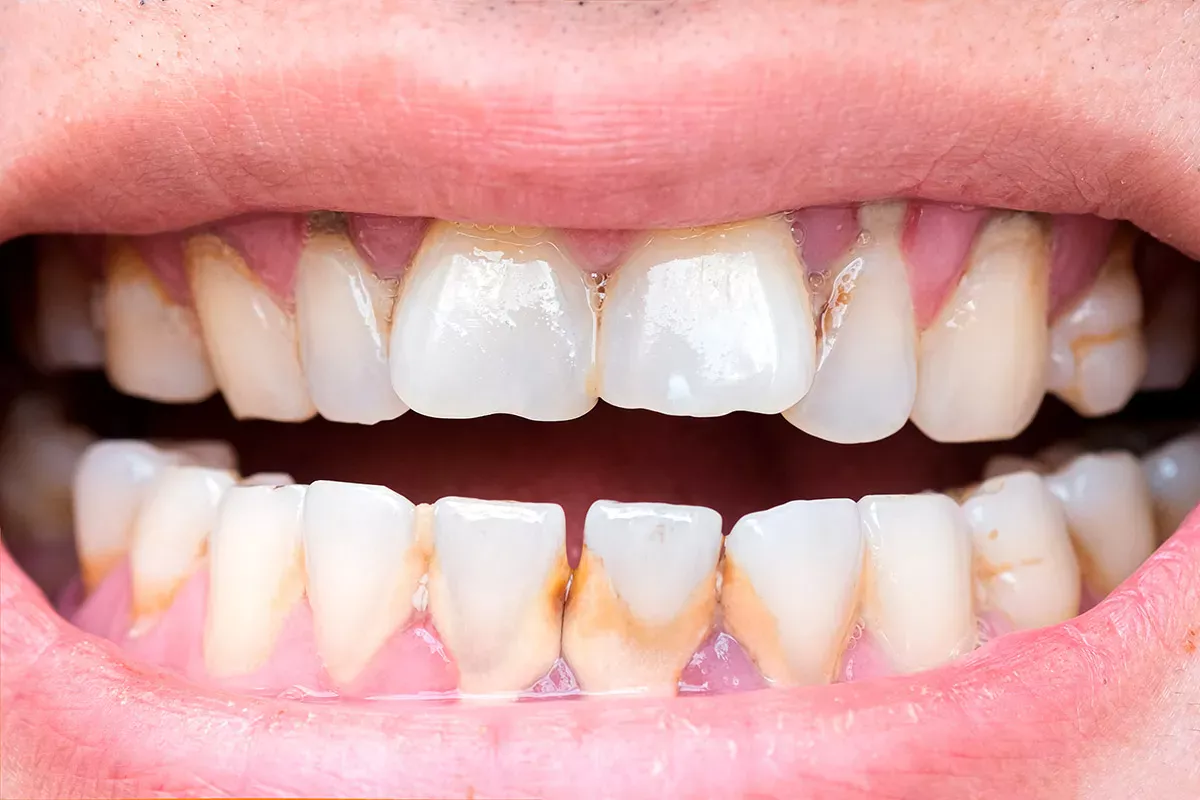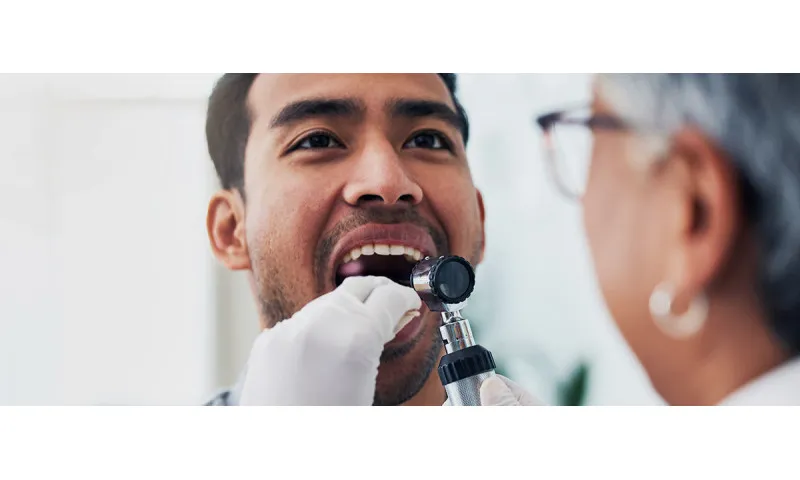Tartar – what is it?
Anyone who goes to the dentist regularly and has their teeth cleaned will certainly have heard the term tartar mentioned more than once. Since no one is immune to it. Even with the best oral hygiene, it spreads and overtime builds up in your mouth – and that is actually quite normal.
The stubborn deposits develop from bacterial plaque. This layer, consisting of food debris, bacteria and saliva, permanently forms on our teeth and in the gum pockets – and there is nothing we can actually do about that.
It is not dangerous at first. But if we fail to remove the initially soft plaque regularly by brushing our teeth, minerals such as calcium and phosphate from saliva become deposited in the biofilm that forms on our teeth. This causes the plaque to calcify and hard tartar to form. The medical term for this is dental calculus.
Good to know:
Thankfully, tartar is painless. Many people, therefore, do not even notice the plaque or do not have it removed professionally. But that is dangerous as serious diseases can be attributed to tartar. Find out which diseases this includes here.
The two types of tartar
There are two different types of tartar or, in medical terms, calculus: Subgingival calculus and supragingival calculus.
Subgingival calculus
The technical term subgingival is composed of the Latin words gingiva (gums) and sub (under) and refers to tartar that occurs beneath the gum line. The hard deposits adhere to the surfaces of the tooth roots and are also medically known as concretions.
Supragingival calculus
This term is also derived from Latin. Supra means above and gingiva – as we already know – gums. Supragingival calculus, therefore, occurs above the gum line, preferably on the inside of the lower front teeth and on the outside of the upper molars. This type of tartar can form quickly but is usually less adherent than subgingival calculus.
What does tartar look like?
What does it look like when you have tartar? Dentists recognise it immediately. Their patients are not always so sure though. For example, they may mistake it for harmless food deposits on their teeth. To prevent this from happening to you, we have put together a few helpful tips.
Self-diagnosis of tartar – how to recognise it
Newly developed tartar typically appears whitish or pale yellow. If the stubborn coating on your teeth fades, the colour can change to brown. With smokers, the tartar on their teeth can even turn black. The colour of tartar is caused by colouring agents in products like tea, coffee and red wine. Bleeding from the gums can also cause discolouration.
Brushing your teeth can reveal whether your plaque has already transformed into tartar. Can it be removed easily? If the answer is yes, you are lucky and have eliminated the precursor of tartar, known as plaque, in time.
However, if the plaque persists, it is probably already tartar. Another indicator of having tartar is the surface texture of your teeth. If you run your tongue over them and they feel rough, the initially soft plaque has probably already hardened. In this case, make an appointment to see your dentist.
Removing tartar yourself? Absolutely not!
Admittedly, removing tartar from your teeth yourself can be tempting. But this is not something we recommend. For example, scraping your teeth with your fingernails in an attempt to remove tartar can lead to lasting damage. Also, please refrain from removing tartar with a needle. You may seriously injure your gums in the process.
Prioritise good dental hygiene – and leave anything that a toothbrush cannot remove to your dentist.
Diagnosis by your dentist
Diagnosing tartar is not difficult for a dentist. Often the challenge lies in raising patient awareness about this matter. To make the preliminary stages of tartar, i.e. the plaque, visible in the truest sense of the word, many dentists employ special staining agents, also referred to as plaque disclosing agents by dental professionals.
Staining can be done in two ways. Either a liquid disclosing agent is applied with a cotton swab or chewable tablets are used. Plaque-coated areas on the teeth are then visibly stained.
Important to know: The staining of teeth usually entails an immediate professional dental cleaning procedure to completely remove all the stains.
Good to know:
Wondering if you have tartar or dental decay? The medical diagnosis is best made by your dentist. Basically, however, dental decay does not show up as whitish-yellowish deposits on your teeth. By the way: Dental decay is practically never found under tartar. Since the bacteria that have settled on the tartar are rendered harmless by the calcification. Nevertheless, this is not a reason to breathe a sigh of relief. Bacteria feel all the more at home on the rough surface of tartar.
Where does tartar occur?
Tartar can basically form on all your teeth. However, since saliva plays a key role in the formation of the hard coating, tartar usually occurs at the excretory ducts of the major salivary glands. They are located in the floor of your mouth next to the lingual frenulum, near the incisors in the lower jaw. Popular places for tartar build-up are thus the inside of the lower front teeth – but also the outside of the upper molars.
Tartar, however, also tends to form in hard-to-reach areas, such as between our teeth, where correct brushing may be challenging. Further popular and hidden places for tartar build-up are the gum pockets.
And what many people do not know: Tartar can even form on piercings in your mouth. Hence, it is essential to maintain and clean your jewellery with the same diligence as you do your teeth. To do so, use your toothbrush and remove food debris and other coatings regularly.
Good to know: Remove tartar also from dentures and braces
Tartar can also form on removable dentures, especially in the spaces between the false teeth. To prevent this from happening, dentures must be cared for in the same way as natural teeth, as tartar accumulation on dentures can result in bad breath and oral fungal infections. This also applies to braces.
Children and tartar
Tartar can also develop on children's milk teeth. In such cases, only a professional dental cleaning procedure can provide the necessary aid. Since children often find it difficult to tolerate such a procedure, it is crucial to prevent tartar from forming in the first place. Therefore, parents should get their children used to a regular oral hygiene routine as early as possible, since regular toothbrushing is the best way to combat tartar.
Good to know:
Between 10 and 15 per cent of children already suffer from dental decay before their third birthday. Therefore, it is important to plan an initial trip to the dentist's as soon as their first milk teeth erupt. As a rule of thumb, this usually happens when babies are about six months old. This also gets your child used to a dental examination at an early age, helping to prevent any potential fears from developing.
Tartar – causes and consequences
Tartar's unsightly appearance is not the only concern; it can also have serious consequences. But where does it actually come from? And what happens if it is left untreated?
The causes at a glance: Why does tartar form?
As mentioned earlier, tartar results from the solidification of unremoved plaque on your teeth. The primary cause of tartar formation is, therefore, the incomplete removal of plaque while it is still soft and easy to remove.
But please do not worry: Even with the best oral hygiene routine, removing all coatings remains a challenge. There are just too many hard-to-reach places in our mouths. So, having tartar does not necessarily mean you are not paying enough attention to oral care and hygiene.
But if you are looking to improve and enhance your oral and dental care and need some helpful tips, we recommend our toothbrushes designed to effectively eliminate plaque.
An incorrect brushing technique can be another cause of tartar build-up in your mouth. Find out how to brush your teeth correctly to eliminate as much plaque as possible here:
Toothbrushing: The correct technique
Did you know that your unique saliva composition also influences your susceptibility to tartar formation? If you suffer from excess tartar, it may be linked to a high mineral content in your saliva. Of course, there is nothing you can do about that – so the guiding principle here is to maintain excellent dental hygiene.
Good to know: Tartar from smoking
Smokers have more plaque on their teeth and, therefore, also develop tartar more readily. Studies have shown that a 20-year habit of smoking 20 cigarettes a day increases the risk of tartar accumulation by a factor of 20.
Consequences of tartar: Gingivitis and periodontitis
Tartar can be removed during a professional dental cleaning session. This is not only recommended for visual reasons, but also important for your overall health. Since: Untreated tartar can lead to periodontitis.
What is periodontitis?
Periodontitis, or periodontosis, is an infectious disease of the complete periodontium triggered by tartar build-up. The hard tartar creates rough tooth surfaces, providing an ideal environment for bacteria to thrive and spread. Subsequently, the metabolism of the bacteria generates toxins that are released there. These toxins can then enter the gums, inducing inflammation of the gums known as gingivitis. This inflammation helps our body to prevent the bacteria from penetrating into deeper tissue for the time being; however, this natural barrier does not last forever. Over time, the gum tissue may pull away from your teeth. Gaps or "pockets" then form between the root of the teeth and the gum line, making it easy for disease-causing bacteria to build up. Left untreated, the bacteria delve deeper into the tissue, your gums recede more and tissue and bone loss may follow. In the worst case scenario, your teeth may fall out.
How can tartar be prevented and treated?
The best defence against tartar is to prevent it from forming in the first place. Discover effective strategies and additional tips to combat stubborn tartar build-up below.
Optimum oral hygiene
If you clean your teeth and tongue regularly and sufficiently, you can remove most of the soft coatings. This is the most effective way to prevent tartar. Since: No plaque, no tartar. Good oral hygiene, preferably using a fluoride toothpaste, is therefore the be-all and end-all.
Professional dental cleaning procedure
Professional dental cleaning helps to both prevent and treat existing hard coatings. This procedure refers to intensive cleaning performed by trained personnel in dental practices. Using different water and powder sprays as well as sonic and handheld instruments, all coatings are removed from your teeth and interdental spaces.
A professional dental cleaning session also includes polishing the surfaces of your teeth and subsequent fluoridation.
In this respect, it is important to know: Reliable studies have yet to confirm the advantages of professional dental cleaning for individuals without periodontitis. However, dentists deem the treatment a vital preventive measure to ensure long-lasting dental health. The German Dental Association, for instance, supports this viewpoint.
How often should tartar be removed?
According to the German Dental Association, healthy individuals are advised to undergo a professional dental cleaning session annually or biannually, while those with deep, difficult-to-reach pockets should consider scheduling a session three or four times a year.
Good to know:
For healthy individuals, the costs for professional dental cleaning are not usually covered by health insurance companies. So before scheduling a session to have tartar removed, ask about the potential costs and consider comparing quoted prices. The prices usually vary considerably.
Can professional dental cleaning do any harm?
Long-term negative consequences have not yet been thoroughly investigated. Currently, it remains uncertain whether professional dental cleaning leads to increased tooth sensitivity or harms tooth surfaces and gums.
One thing is certain though: Having your teeth cleaned professionally can cause discomfort, particularly if the necks of your teeth are exposed. Furthermore, if your gums are already irritated or inflamed, cleaning can lead to bleeding of the gums.
There is also no need to feel embarrassed if you have concerns about getting your teeth cleaned. It is best to express your fears and concerns openly. Typically, your dentist or dental hygienist will take extra care in such situations. You can also opt to apply a desensitising agent to your teeth. Even local anaesthesia might be an option. Just make sure to get good advice.
Tartar removed, now in pain? This can happen
A professional dental cleaning session can be stressful for your teeth and the entire oral cavity. For example, the necks of your teeth may be particularly sensitive afterwards. Luckily, this pain usually disappears after a few hours. If it does not go away, you should get back in touch with your dentist.
Does dental cleaning lead to permanently whiter teeth?
Naturally, many patients hope for this outcome, and indeed, your teeth should appear whiter and brighter after the said treatment. However, it is important to note that if you smoke or consume coffee or black tea, your teeth may become discoloured again, potentially within just a few weeks. Unfortunately, that cannot be prevented.
Avoid sugar
Refrain from consuming high-sugar foods or eat them in moderation. They promote bacterial growth and thus the formation of plaque. Moreover, when sugar is added, the bacteria generate acids that erode the tooth surface – paving the way for the imminent development of dental decay.
Can I use home remedies like bicarbonate of soda or baking powder? Please don't!
The Internet is full of tips on how to naturally remove tartar, such as using bicarbonate of soda or baking powder. We do not recommend any of these home remedies as they can damage the enamel of your teeth. Furthermore: The most effective remedy against tartar is to remove soft coatings from your teeth regularly – simply by brushing your teeth thoroughly. Stubborn coatings should be left to the professionals.
Sources
German Federal Ministry of Education and Research: Keine Chance der Parodontitis, at: www.gesundheitsforschung-bmbf.de.
German National Association of Statutory Health Insurance Physicians: Der erste Zahnarztbesuch, at: www.kzbv.de.
Christina Hohmann-Jeddi: Verkalkte Plaque, at: www.pharmazeutische-zeitung.de, issue 37/2016.
Heyn, Gudrun: Rauchen schadet den Zähnen, at: www.pharmazeutische-zeitung.de, issue 21/2010.
Dr. Melzer, Martina: Zahnstein: Entfernen lassen!, at: www.apotheken-umschau.de, updated on 20 February 2020.
Diabetes-Deutschland.de: Diabetes und Zähne: Zahnpflege.
Federation of German Consumer Organisations: Professionelle Zahnreinigung (PZR): Das sollten Sie darüber wissen, at: www.verbraucherzentrale.de, updated: 3 March 2023.
German Institute for Quality and Efficiency in Health Care (IQWiG): Zahnfleischentzündung und Parodontitis, at: www.gesundheitsinformation.de.
Welche Vor- und Nachteile hat die professionelle Zahnreinigung?, at: www.gesundheitsinformation.de.
IGeL-Monitor: Professionelle Zahnreinigung.
German Dental Association: Professionelle Zahnreinigung (PZR) and Handbuch der Mundhygiene, at: www.bzaek.de.
Hellwege, Klaus-Dieter: Die Praxis der zahnmedizinischen Prophylaxe, Thieme-Verlag, issue from 2003.
Dr. Skibba, Werner: Reinigung vom herausnehmbaren Zahnersatz, at: dr-skibba.de.
Fair-Doctors: Zahnstein bei Kindern – Ursachen & vorbeugen, at: fair-doctors.de.
Zahnstein-entfernen.info: Zahnstein bei Kindern: Wichtige Infos über Entfernung & Vorbeugung
Landesarbeitsgemeinschaft Berlin zur Verhütung von Zahnerkrankungen (Gruppenprophylaxe) e.V.: Wann soll das Kind zum ersten Mal zum Zahnarzt oder zur Zahnärztin?, at: www.lag-berlin.de.
Stern.de: Bakterien-Alarm im Mund.
Zahnarztpraxis „Smilist“: Zahnstein – Ursachen und Behandlung, at: www.smilist.de.
Zahnarztpraxis Groeschel: Zahnbelag verursacht Zahnfleischbluten, at: www.zahnarztpraxis-groeschel.de.
All websites last accessed on 22 March 2023.
 Swiss premium oral care
Swiss premium oral care







